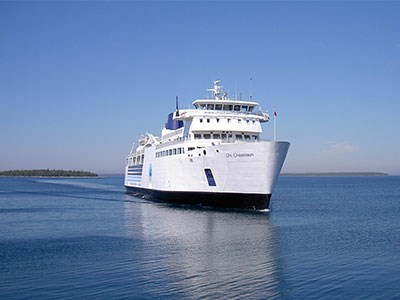The Owen Sound Transportation Company (OSTC) will implement changes to the operation of the Chi-Cheemaun ferry following the release of a report warning declining ridership could spell trouble for the ship in the next five years.
Released in March, the MS Chi-Cheemaun Market Feasibility Study compiled by CPCS alarmed tourist outfitters, especially on Manitoulin Island, which rely on the Chi-Cheemaun to ferry passengers between South Baymouth and Tobermory during its busy summer tourist season.
Susan Schrempf, president and CEO of OSTC, which runs the ferry, said forecasting its imminent demise is a misinterpretation of the report.
“The reason this study was done was so that we don’t end up in that situation, that we look now and be proactive now about making changes to the ferry so that we don’t end up just dwindling down to nothing,” she said.
The report indicates traffic decreased from 232,000 passengers in 2005 to 170,000 passengers in 2011, a 27 per cent decrease in ridership. The economic downturn, higher fuel prices, higher Canadian dollar exchange rates, changing travel and spending habits, and recent road improvements to the region are cited as reasons for the drop.
If action isn’t taken, the report predicts ferry traffic will decline between 2.5 per cent and 3.5 per cent annually, with ridership dropping to 139,000 between 2018 and 2020.
Because the ferry was designed as a transportation system and not specifically for tourism, addressing these challenges means an entire cultural shift for the company, said Schrempf.
“We’ve been carried along the (tourism) wave for many, many years, but we’re not a large company and we spend 99 per cent of our time making sure the ferry is properly maintained, properly manned, following all of the regulations, and operating as safely as possible, and that’s a full-time job,” Schrempf said. “So we now have to devote resources or contract for resources to be able to promote the ferry for what it really is. It does transportation, but it’s a part of a bigger destination, a tourism experience.”
All the ferry’s fares go towards its $8-million operating budget, while capital investments are made by the province. Regular, scheduled maintenance keeps the ship in “fantastic shape,” Schrempf said.
The issue of low ridership was exacerbated this spring by low water levels. Operation of the vessel was delayed by two weeks, because low water levels meant the ship couldn’t be operated safely. Bumpers at the docks at both ports had to be replaced, and Schrempf anticipated the work would be completed by mid-July.
“They removed wood timbers and they’re being replaced by fabricated steel timbers with a special plastic coating on the outside to prevent abrasion on the ferry,” Schrempf said. “But these steel ones will last much longer and so that will accommodate the ferry at lower water levels.”
Water levels have risen since the spring, but their cyclical nature means the company will face similar issues in the fall.
While Tobermory’s port is deep, South Baymouth’s is much shallower, and Schrempf said the OSTC may have to consider dredging the bay. It would be a lengthy and expensive process, especially because of the rock at South Baymouth. Shale can be chipped away, but the rock would require blasting.
“When you talk about dredging in the South Baymouth channel, it’s a long time from start to actually doing it,” Schrempf said. “So it needs to have some serious consideration now so when the time comes, everything is in place so it can be done.”
In the meantime, changes from the report are already being implemented to make the ferry a more attractive transportation option for travellers.
The OSTC has replaced reservation fees with peak and off-peak fares; there’s more flexibility in the one-hour reservation cutoff; passengers are eligible for a free ride after nine paid sailings under its frequent user program; and the OSTC website is currently being overhauled.
Long-term changes, largely tied to marketing and enhancing the travel experience, have been identified for implementation over the next one to three years.
The company is starting by marketing to areas such as Toronto, which hasn’t been addressed for several years, and creating tourism packages and experiences.
“We do know it has to be a quality experience, because you can’t expect people to pay money for something that’s going to be substandard,” Schrempf said. “Our expertise is not in that; our expertise is in the physical operation of ferries. So that’s why we have to go outside of ourselves to find people who are expert at putting packages together and being able to promote them effectively.”
Manitoulin is already taking a proactive approach, working with Ministry of Tourism to promote bicycle tourism, which has increased in recent years.
www.ontarioferries.com




